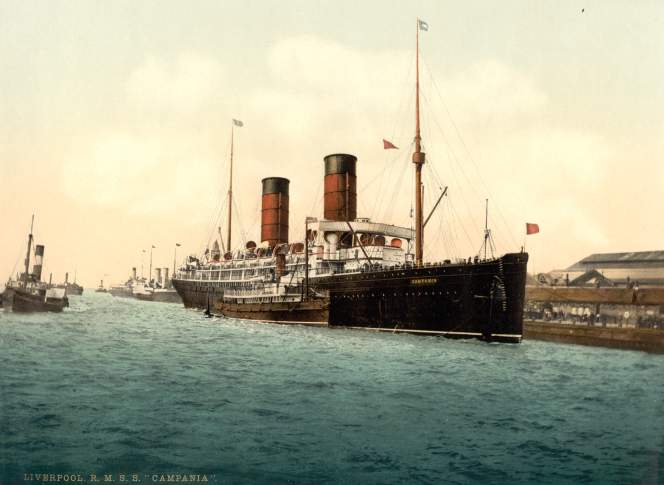When Place Of Birth Is At Sea
While place of birth is straightforward for most people, for a few the waters are uncertain.
January 22, 2018

R.M.S. Campania in Liverpool, England illustration

Counting millions upon millions of people is a big job for the U.S. Census Bureau, and in some ways, a messy process. For example, what’s the address for somebody who lives on a boat or RV? Should green-and-gold snowbirds who winter in the Sunshine State be counted in Wisconsin or Florida? For separated parents who share custody of children, at whose address do the children reside? What about persons who were born (or died) on April 1 — Census Day in the United States — are they to be counted in the population for that year?
While place of birth is straightforward for most people, for a few the waters are uncertain. Births at sea have been relatively rare for decades, but it was much less unusual during the large transatlantic immigration waves of the 1800s and early 1900s, when many migrants arrived in the U.S. seeking a better life after a long journey by ship. Among the people who have been born at sea, notable Midwesterners include Henry W. Orth, a prominent architect whose parents were on their way from Norway to St. Paul, Minnesota, and Moses O. Williamson, a son of two Swedish immigrants who served a term as Illinois State Treasurer in 1900.
The experiences of these immigrants reveals a minor curiosity of American history: for well over a century, the U.S. Census has counted people who were “born at sea” as foreign-born, but in their own category separate from their countries of origin. Indeed, even residents of Wisconsin who were born outside the U.S. have included those who took their first breaths en route.
A complete count of every person residing in the United States is required every 10 years by the U.S. Constitution, which in Article I, Section 2 states: “Representatives [to Congress] … shall be apportioned among the several States which may be included within this Union, according to their respective Numbers… The actual Enumeration shall be made … within every subsequent Term of ten Years, in such Manner as they shall by Law direct.”
This enumeration was completed for the first time in 1790, and has been repeated every 10 years since then. The U.S. Marshals Service conducted the first nine decennial censuses. In 1880, the U.S. Census Bureau was established to take over the process, and has conducted a complete population count 23 times. In addition to the number of people, the Census collects information about place of birth, gender, race and other demographic details that inform policymaking, budgeting, and representation in government. The 24th decennial census will occur in 2020, and among other outcomes, its results will determine apportionment of representatives in state legislatures and Congress.
The portion of people born at sea is but a very minor drop in the ocean of population growth in the U.S. Nationally, the nation’s born at sea cohort peaked in 1900 with an estimated 8,100 persons, as detailed in a 2006 Census report about the foreign-born population of the U.S. As immigration patterns and modes of transit evolved, this number has dwindled to just a few, making them a footnote in American history.
Although the Census Bureau attempts to count every U.S. resident, they do not report every subgroup. Due to the very small numbers involved, the number of people born at sea for the 1940-1990 censuses are not publically available.
However, when the Census Bureau makes data available online, more information can be shared. In a table showing the nations of origin for the U.S. foreign-born population from the 2000 census, born at sea is provided as a separate category. The table shows 316 persons who were born at sea living in the U.S. at that time. In addition, a 2010 Census report on region of birth for the foreign-born population lists 181 people who were born at sea in a literal footnote.

In 1910, just after the peak of the European immigration wave, Wisconsin’s born at sea population was around 400 persons. This number was nearly 6 percent of the entire U.S. born at sea population at that time, and reflected the tremendous growth of European immigration and settlement in the state. However, as of 2000 — the most recent year for which the Census Bureau provided a state level count for this group — there were just seven Wisconsin residents who were born at sea, about 2 percent of the national population.

People who are born on ships in international waters — or planes in international airspace — face two tricky administrative questions. In the U.S., people born in transit face the question of where to list their place of birth. The U.S. State Department’s policy is that place of birth be listed as “at sea” or “in the air,” respectively. Although the State Department differentiates between born at sea and born in the air, the Census Bureau counts so few of such people that two categories are not needed. Therefore, when the Census enumerates the nation’s population every 10 years, people born in ships or in flight traveling in or over international waters fall into a special category for place of birth: born at sea.
The Fourteenth Amendment to the U.S. Constitution stipulates that people born on American soil will be granted citizenship to the nation, but for a few rare exceptions. However, citizenship for people born while in transit to the U.S. is not automatic. For decades, citizenship in these cases has been a sticky legal problem, and there have even been international treaties to address it. Today, people born in transit are generally considered citizens of the nation in which the vessel is registered.
 Passport
Passport













Follow Us